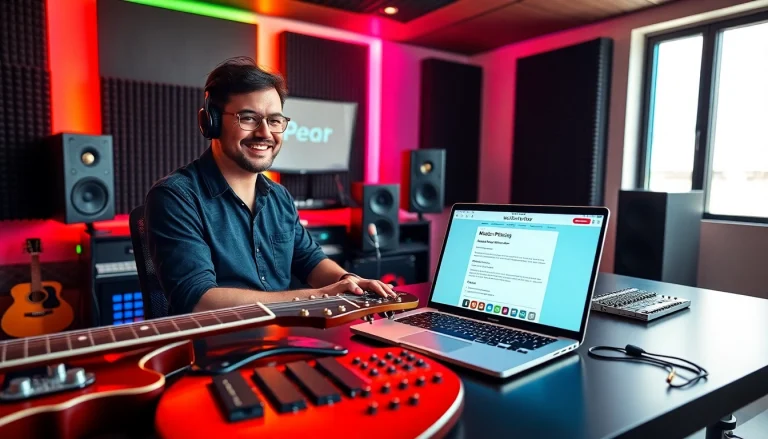Understanding the Basics of Editing & Post-Production
What is Editing & Post-Production?
Editing & Post-Production is the critical phase of the video production process that occurs after filming has concluded. It encompasses a variety of processes designed to enhance and finalize raw footage into a polished final product. During this stage, editors work meticulously to piece together the narrative, add visual effects, and enhance audio elements. The aim is to transform the captured moments into a cohesive and engaging viewing experience. Interested in delving deeper? Check out this resource on Editing & Post-Production.
The Importance of Editing & Post-Production in Filmmaking
The significance of editing & post-production cannot be overstated. This phase allows filmmakers to sculpt the story they wish to tell. It is not merely about cutting out errors or lengthy scenes but about shaping the very essence of the film. A well-executed post-production process can elevate a mediocre film into an extraordinary piece of art, enhancing clarity, pacing, and emotional impact. In many cases, the success of a film largely hinges on how effectively the editing and post-production process has been executed. Creators have the opportunity to refine audio, insert effects, and ensure that every segment contributes meaningfully to the narrative.
Common Terminology in Editing & Post-Production
Understanding the jargon associated with editing & post-production is essential for both filmmakers and aspiring editors. Here are some commonly used terms:
- Cut: A direct transition from one shot to another.
- Montage: A series of shots edited together to condense space, time, and information.
- Color Grading: The process of altering and enhancing the color of a motion picture.
- Visual Effects (VFX): The process of creating or manipulating imagery that cannot be captured on film or video.
- Audio Mixing: The process of combining different audio tracks to create a balanced and cohesive sound.
Key Steps in the Editing & Post-Production Process
Pre-Editing Preparations and Planning
The foundation for effective editing lies in thorough preparation before the actual editing begins. It is crucial to organize the raw footage, categorizing it based on scenes, takes, and angles. This not only streamlines the editing process but also helps the editor maintain a clear understanding of the available content. Creating a detailed storyboard or shot list can also guide editors in recognizing where they can enhance the narrative. Furthermore, developing a post-production schedule can aid in timely completion, allowing creators to establish deadlines and expectations for drafts.
Detailed Workflow: From Footage to Final Cut
The editing workflow can vary depending on the project, but a common path taken includes:
- Importing and Organizing Footage: This involves transferring the raw video files to the editing software and organizing them systematically.
- Rough Cut: A preliminary version of the video is assembled, where editors focus on piecing together the narrative without worrying about finer details.
- Fine Cut: This is where more delicate adjustments are made, smoothing out transitions and ensuring that pacing feels right.
- Color Correction and Grading: Adjusting colors to maintain continuity, enhance visual appeal, and evoke intended emotions.
- Sound Design: This includes editing audio clips, adding sound effects, and ensuring dialogue clarity.
- Final Review: Before the final export, a comprehensive review occurs, checking every element for quality, consistency, and adherence to the creative vision.
Integrating Sound and Visual Effects
The integration of sound and visual effects is paramount in elevating a video project. Sound design enhances the viewer’s experience, making the film more immersive. This can involve adjusting background noise, adding sound effects, and layering music to enhance emotional moments. Similarly, visual effects, whether subtle or extravagant, can dramatically influence the perception of a film. Examples include CGI elements, animated graphics, or simple corrections like green screen effects. The collaboration between sound and visuals creates a harmonious blend that captivates and engages audiences.
Best Practices for Effective Editing & Post-Production
Editing Techniques for Different Genres
Different genres demand different editing styles. Understanding these unique requirements can enhance storytelling significantly:
- Action Films: Fast-paced editing with quick cuts to maintain adrenaline and excitement.
- Documentaries: A more measured approach with emphasis on narrative flow and continuity.
- Drama: Slower pacing; editing is used to spotlight emotional moments and character development.
- Comedies: Timing is crucial; clever cuts can enhance comedic effect.
By adapting editing techniques to fit the genre, editors can effectively support storytelling and audience engagement.
Using Software Tools Effectively
The right software is an essential component of successful editing & post-production. Familiarity with popular editing platforms such as Adobe Premiere Pro, Final Cut Pro, or DaVinci Resolve allows editors to maximize the tools at their disposal. Each platform offers unique features, from advanced color grading tools to robust sound editing capabilities. Understanding the strengths and best practices for utilizing these tools can significantly improve workflow efficiency and output quality.
Collaborative Workflows in Editing & Post-Production
Editing & Post-Production is often a collaborative effort, requiring seamless communication among various team members such as directors, producers, and sound engineers. Establishing a clear workflow and communication plan is vital. Utilizing collaboration tools like shared drives and project management software can enhance this process, ensuring that everyone involved is on the same page. Regular feedback sessions and check-ins also help in smoothing out potential issues before they escalate.
Challenges in Editing & Post-Production and How to Overcome Them
Common Pitfalls to Avoid
Despite the best planning, pitfalls can occur during editing & post-production. Some common challenges include:
- Over-editing: Less can be more; excessive cuts can disrupt narrative flow.
- Ignoring Sound Quality: Poor audio can detract from an otherwise engaging video.
- Timeline Mismanagement: Rushing through editing can lead to a lack of polish.
Aiming for a balanced approach helps mitigate these risks, allowing each stage of the editing & post-production to receive proper attention.
Managing Feedback and Revisions
Feedback is an integral part of the editing process, allowing creators to identify strengths and areas needing improvement. However, managing feedback can be challenging. It is essential to establish a structured feedback mechanism where all team members can provide input in a constructive manner. Additionally, tracking revisions effectively through version control can prevent confusion and ensure that all changes are documented and considered.
Time Management Strategies for Editors
Effective time management is crucial in the editing & post-production phase. Editors can benefit from establishing clear deadlines for each part of the process. Utilizing calendars and task management tools to create schedules and setting minutely goals for daily work can help maintain productivity. Allocating time for breaks is also vital, as it can help prevent burnout and maintain high levels of creativity throughout the project.
Measuring Success in Editing & Post-Production Projects
Defining Key Performance Indicators (KPIs)
To evaluate the effectiveness of editing & post-production, establishing key performance indicators (KPIs) is essential. Common KPIs in this field may include factors such as audience engagement metrics, viewer retention rates, and feedback ratings from test screenings. By defining what success looks like from the outset, editors and creators can focus their efforts on achieving those specific goals.
Audience Engagement Metrics
Audience engagement serves as a critical measure of a video’s impact. Analytics platforms provide valuable insights into viewer behavior; metrics such as watch time, likes/dislikes, shares, and comments can reveal how well the content resonated with audiences. Understanding these metrics allows filmmakers to determine what worked and what didn’t, guiding future editing & post-production efforts.
Improving Future Projects Based on Performance Data
Post-mortem analysis after a project’s completion can reveal invaluable lessons. By reviewing performance data and receiving additional feedback, teams can identify areas for improvement in both the editing process and final product. This knowledge not only aids in refining technical editing skills but also deepens understanding of narrative structure, pacing, and audience engagement strategies necessary to achieve storytelling goals effectively.








